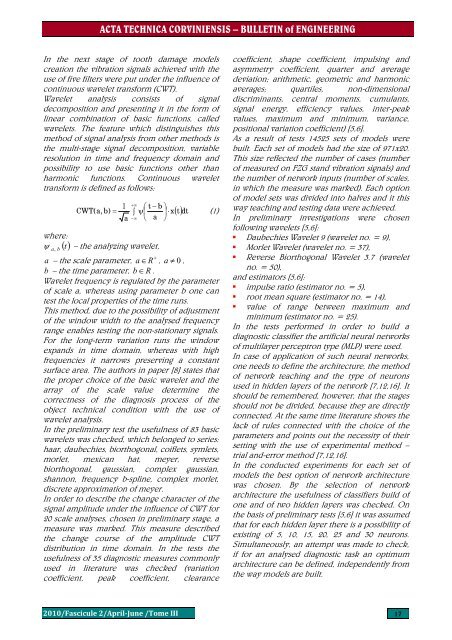ACTA TECHNICA CORVINIENSIS - Bulletin of Engineering
ACTA TECHNICA CORVINIENSIS - Bulletin of Engineering
ACTA TECHNICA CORVINIENSIS - Bulletin of Engineering
- No tags were found...
Create successful ePaper yourself
Turn your PDF publications into a flip-book with our unique Google optimized e-Paper software.
<strong>ACTA</strong> <strong>TECHNICA</strong> <strong>CORVINIENSIS</strong> – BULLETIN <strong>of</strong> ENGINEERINGIn the next stage <strong>of</strong> tooth damage modelscreation the vibration signals achieved with theuse <strong>of</strong> five filters were put under the influence <strong>of</strong>continuous wavelet transform (CWT).Wavelet analysis consists <strong>of</strong> signaldecomposition and presenting it in the form <strong>of</strong>linear combination <strong>of</strong> basic functions, calledwavelets. The feature which distinguishes thismethod <strong>of</strong> signal analysis from other methods isthe multi-stage signal decomposition, variableresolution in time and frequency domain andpossibility to use basic functions other thanharmonic functions. Continuous wavelettransform is defined as follows:1+∞⎛ t − b ⎞CWT(a,b) = ∫ ψ⎜⎟⋅xa −∞ ⎝ a ⎠where:ψ t – the analyzing wavelet,a, b()()dt t(1)a – the scale parameter, a ∈ R , a ≠ 0 ,b – the time parameter, b ∈ R .Wavelet frequency is regulated by the parameter<strong>of</strong> scale a, whereas using parameter b one cantest the local properties <strong>of</strong> the time runs.This method, due to the possibility <strong>of</strong> adjustment<strong>of</strong> the window width to the analysed frequencyrange enables testing the non-stationary signals.For the long-term variation runs the windowexpands in time domain, whereas with highfrequencies it narrows preserving a constantsurface area. The authors in paper [8] states thatthe proper choice <strong>of</strong> the basic wavelet and thearray <strong>of</strong> the scale value determine thecorrectness <strong>of</strong> the diagnosis process <strong>of</strong> theobject technical condition with the use <strong>of</strong>wavelet analysis.In the preliminary test the usefulness <strong>of</strong> 83 basicwavelets was checked, which belonged to series:haar, daubechies, biorthogonal, coiflets, symlets,morlet, mexican hat, meyer, reversebiorthogonal, gaussian, complex gaussian,shannon, frequency b-spline, complex morlet,discrete approximation <strong>of</strong> meyer.In order to describe the change character <strong>of</strong> thesignal amplitude under the influence <strong>of</strong> CWT for20 scale analyses, chosen in preliminary stage, ameasure was marked. This measure describedthe change course <strong>of</strong> the amplitude CWTdistribution in time domain. In the tests theusefulness <strong>of</strong> 35 diagnostic measures commonlyused in literature was checked (variationcoefficient, peak coefficient, clearance+coefficient, shape coefficient, impulsing andasymmetry coefficient, quarter and averagedeviation; arithmetic, geometric and harmonicaverages; quartiles, non-dimensionaldiscriminants, central moments, cumulants,signal energy, efficiency values, inter-peakvalues, maximum and minimum, variance,positional variation coefficient) [5,6].As a result <strong>of</strong> tests 14525 sets <strong>of</strong> models werebuilt. Each set <strong>of</strong> models had the size <strong>of</strong> 971x20.This size reflected the number <strong>of</strong> cases (number<strong>of</strong> measured on FZG stand vibration signals) andthe number <strong>of</strong> network inputs (number <strong>of</strong> scales,in which the measure was marked). Each option<strong>of</strong> model sets was divided into halves and it thisway teaching and testing data were achieved.In preliminary investigations were chosenfollowing wavelets [5,6]:• Daubechies Wavelet 9 (wavelet no. = 9),• Morlet Wavelet (wavelet no. = 37),• Reverse Biorthogonal Wavelet 3.7 (waveletno. = 50),and estimators [5,6]:• impulse ratio (estimator no. = 5),• root mean square (estimator no. = 14),• value <strong>of</strong> range between maximum andminimum (estimator no. = 25).In the tests performed in order to build adiagnostic classifier the artificial neural networks<strong>of</strong> multilayer perceptron type (MLP) were used.In case <strong>of</strong> application <strong>of</strong> such neural networks,one needs to define the architecture, the method<strong>of</strong> network teaching and the type <strong>of</strong> neuronsused in hidden layers <strong>of</strong> the network [7,12,16]. Itshould be remembered, however, that the stagesshould not be divided, because they are directlyconnected. At the same time literature shows thelack <strong>of</strong> rules connected with the choice <strong>of</strong> theparameters and points out the necessity <strong>of</strong> theirsetting with the use <strong>of</strong> experimental method –trial and-error method [7,12,16].In the conducted experiments for each set <strong>of</strong>models the best option <strong>of</strong> network architecturewas chosen. By the selection <strong>of</strong> networkarchitecture the usefulness <strong>of</strong> classifiers build <strong>of</strong>one and <strong>of</strong> two hidden layers was checked. Onthe basis <strong>of</strong> preliminary tests [5,6] it was assumedthat for each hidden layer there is a possibility <strong>of</strong>existing <strong>of</strong> 5, 10, 15, 20, 25 and 30 neurons.Simultaneously, an attempt was made to check,if for an analysed diagnostic task an optimumarchitecture can be defined, independently fromthe way models are built.2010/Fascicule 2/AprilJune /Tome III 17
















